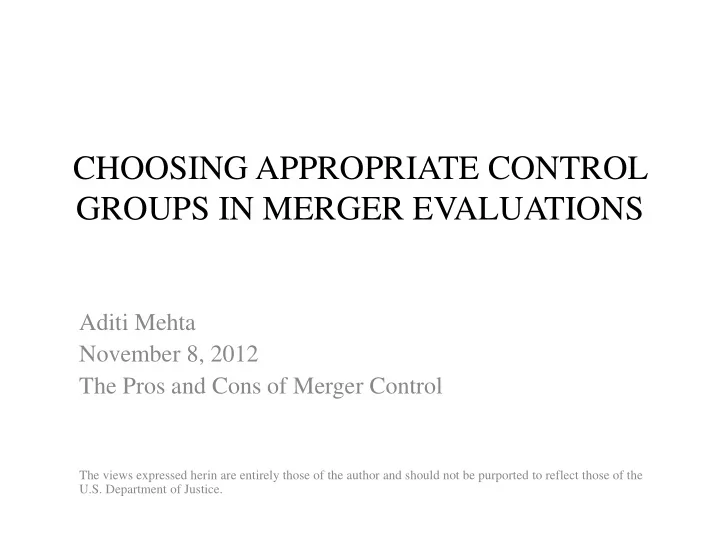

CHOOSING APPROPRIATE CONTROL GROUPS IN MERGER EVALUATIONS Aditi Mehta November 8, 2012 The Pros and Cons of Merger Control The views expressed herin are entirely those of the author and should not be purported to reflect those of the U.S. Department of Justice.
INTRODUCTION • Explore how the selection of the comparison group can affect the results of differences-in-differences analysis. • Focus on Delta-Northwest merger: – Airline industry features 1,000s of routes that were unaffected by the merger. – Merger occurred at a time of recession – highlights importance of appropriate control group. • Provide one example and discussion of possible future work. 2
IMPORTANCE OF MERGER RETROPECTIVES • Empirical evidence on the price effects of mergers: – Can determine whether past antitrust enforcement was applied correctly – Can help regulators to develop more effective techniques to forecast the likely effects of mergers on competition 3
CHALLENGES IN MERGER RETROSPECTIVES • It can be difficult to get appropriate data. • Necessitates knowledge of what prices would have been had the merger not occurred. – Look at prices of merging firms before and after the merger. – Use a differences-in-differences approach. 4
AIRLINE MERGER RETROSPECTIVES Paper Merger Examined Control Group Results Borenstein TWA-Ozark and Industry average prices Northwest-Republic (1990) Northwest-Republic for similar distance merger led to a price increase. which occurred in routes. 1986 -Number of competitors -Service out of hubs Kim and Singal 14 airline mergers Routes on which neither Prices increased by from 1985-1988 (1993) of the merging firms 10% on average. operated of similar distances. 5
DELTA-NORTHWEST MERGER • In April 2008 Delta Air Lines and Northwest Airlines announced plans to merge. – $3.1 billion transaction – created the largest airline in the world • Approved by the DOJ after a 6-month investigation. • By January 2009 ground operations and reservations systems had been combined. • In the next year the airlines combined terminals and gates at various airports and reward programs. 6
OTHER PRESSURES ON AIRFARE • Decrease in demand due to recession: – High unemployment rates – Decrease in corporate budgets – Recession hit different communities to differing degrees • Introduction of baggage fees and increase in ancillary fees. 7
DATA • DB1B data: Passenger Origin-Destination Survey of the US DOT – 10% sample of all airline tickets – Quarterly from 2006-2011 – Exclude Q2 2008-Q1 2009 • Official Airline Guide to identify airline schedules. • Census data. 8
CONNECT ROUTES • Focus of this paper are connecting routes. • May be less harm on these routes because easier entry? – Fewer and fewer independent carriers. – Large potential for harm on routes with overlap: Routes 4,222 Passengers 36 million Volume of Commerce $8 billion 9
DESCRIPTIVE STATISTICS Unaffected by the All Routes Affected by the Merger Merger $257 $248 $270 Average Fare Average Number of 1,058 1,101 1,000 Miles Average Number of 2.9 3.7 1.9 Competitors Average Number of 0.2 0.3 0.1 LCCs Average HHI 6,038 4,867 7,635 Average Endpoint 7.8% 7.9% 7.7% Unemployment Rate Average Endpoint 1,637,874 1,657,204 1,611,531 Population 7,320 4,222 3,098 Number of Routes 16,822,929 13,660,845 3,162,078 Number of Passengers 10
REGRESSION ANALYSIS ln(Price) qm = a + b*overlap_pre m *post q + c*avg_pop qm + d*avg_unemp qm + r + t Variables Coefficient 0.04* Merger Effect (0.005) Simulated HHI -3.09*10 -6 * Average Population (5.79*10 -7 ) -5. 21* Average Unemployment (1.29) Observations 111,792 • Price effect of the merger is about 4% on connecting routes. 11
EFFECT OF THE MERGER BY ROUTE SIZE Merger Effect Variables for: 0.03* Routes with < 2,000 Passengers (0.006) 0.03* Routes with 2,001-4,000 Passengers (0.006) 0.04* Routes with 4,001-10,000 Passengers (0.006) 0.06* Routes with 10,000 + Passengers (0.005) -3.269*10 -6 * Average Population (1.38*10 -7 ) -6. 05* Average Unemployment (1.31) Observations 111,792 12
ONE DIFFERENCE IN TREATED AND CONTROL ROUTES 13
PRICE CHANGES IN BY ROUTE SIZE Affected by the Merger Unaffected by the Merger Size of Route # of Routes # of Routes % Change % Change Price Price (Yearly Passengers) 0-2,000 -1.0% 1,094 -4.8% 2,026 2,000-4,000 -1.0% 1,155 -2.3% 690 4,001-10,000 -0.5% 878 -0.0% 244 10,001+ +1.7% 1,095 +1.1% 138 All 0.0% 4,222 -3.2% 3,098 14
REGRESSION RESULTS WITH DIFFERENT SET OF CONTROL ROUTES Route Size: More than 10,000 Passengers Control Group: All Control Group: Similar Number of Passengers Overlap 0.064* -0.002 (0.003) (0.011) Observations 67,088 19,728 15
DIFF-N-DIFF WITH BEST MATCH CONTROL ROUTE • Design a control group of routes based on the number of passengers pre-merger. – For each treated route find a route from those not affected by the merger that is most similar in terms of yearly passengers. Coefficient 0.01* Overlap (0.004) Simulated HHI Observations 128,672 16
OTHER FACTORS THAT MAY AFFECT CHOICE OF CONTROL ROUTE • Levels of fares • Pre-merger trends in fares • Number of competitors, number of LCCs • Initial concentration level • Demographic characteristics • Number of passengers 17
FUTURE WORK • Matching estimators where control routes are selected on the basis of multiple characteristics. – Can incorporate endogenous outcomes. – However, can be sensitive to the number of controls that are selected. • Construct synthetic routes, which are weighted averages of all available routes – Weights are selected so that the synthetic route most closely resembles the treated route. 18
Recommend
More recommend